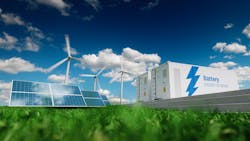New Study Details Clean Energy's Potential
Clean energy resources, which include wind, solar, energy storage, hydropower and other renewables, represent a major opportunity to drive U.S. economic recover and add hundreds of thousands of jobs. According to a new study released today by global natural resources research consultancy Wood Mackenzie and the American Clean Power Association (ACP), reaching a majority renewables grid will deploy over $1 trillion in capital investment into the American economy over the next decade, while supporting 980,000 direct jobs, stabilizing wholesale power prices, and reducing U.S. carbon emissions by over 60%. Targeted administrative actions and legislative policies are essential for the U.S. to achieve these benefits within the next ten years.
"A majority renewables electric system for the U.S. is possible within a decade and will deliver much-needed investments in our economy and create a pathway toward steady, well-paying employment for workers across the country," said ACP Senior VP of Government and Public Affairs Amy Farrell, in the release. "This research shows that a collaborative promise of an American grid powered by wind, solar, hydropower, energy storage and other renewables represents an economic powerhouse that will lead our country towards a more prosperous, healthier and cleaner future."
A recently released Clean Energy Road Map proposed by the American Wind Energy Association (AWEA), which is merging with the ACP in January 2021, lays out how the U.S. federal government can rapidly accelerate this economic growth and renewable energy deployment through executive and legislative action starting in 2021.
Some of the key findings of the Wood Mackenzie study include:
- Administrative actions alone can double renewable energy penetration within the next decade.
- Transmission-focused policies are critical to unlocking renewable potential.
- Presidential administrative and legislative actions driving up to 50% renewable energy by 2030 can be a major source of economic stimulus.
“This comprehensive analysis demonstrates that transforming the U.S. power grid is technically and commercially feasible, with appropriate policy support," said Aaron Barr, principal consultant in Wood Mackenzie's Energy Transition Practice, in the release.
The transition to a majority renewables electric grid will be led by significant growth in land-based wind, offshore wind, and solar capacity, alongside a corresponding increase in energy storage development. The job growth and investments associated with these new additions will far outweigh the losses as the nation phases out or retires legacy power technologies. Unsurprisingly, this transition to a majority renewables future results in a significantly cleaner grid. During the decade, carbon emissions are estimated to decrease 60%, a level in line with the country’s economy-wide target under the Paris Agreement.
For more information, read the original release from AWEA.
